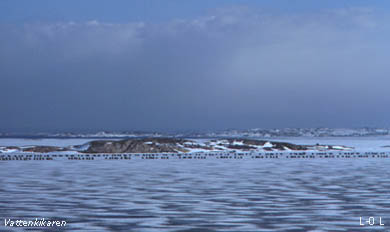|
|
|
The cultivation of molluscs
The cultivation of molluscs is an old tradition. After fish, molluscs
are the most commonly cultivated Marine organisms in the world. Oysters
and blue mussels represent about 90% of the molluscs that are cultivated.
Blue mussels dominate in Europe, while the cultivation of oyters dominate
in Japan and USA. In South Korea, Taiwan and USA, the cultivation
of different thick shelled mussel specie occurs. In Japan large quantities
of scallops are cultivated, while in Malaysia cockles are popular.
Even pearl oysters are cultivated, but only for the production of
pearls.

The blue spots in the distance are large plastic barrels frozen
in the ice that are used as floats to hold the mussels in free water
as used in the so called long line method.
Trials in the cultivation of blue mussels started in Sweden around
1970. Although the number of Swedish mussel farms has steadily increased
in number, the production of mussels is still relatively low compared
to many other countries. The largest producer of cultivated blue mussels
today is Spain where they are cultivated from rafts. In Sweden, the
long line method of cultivation is by far the most common.
Other large European producers of blue mussels are the
Netherlands (bottom cultivation) and France (pole method). On Ireland,
about half of the production is the result of bottom cultivation,
while the other 50% is prodced on long lines. In Denmark (Limfjord)
the method of mussel cultivation resembles fishing for wild mussels.
Naturally occurring mussels are scraped up from the bottom, but where
bottom falling is controlled so the fishermen know which areas to
fish and when. To protect the diversity of specie within the fjord,
40% of its area is exempted from mussel fishing.
|